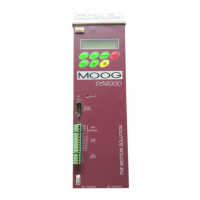SECTION FIVE – COMPONENT DESCRIPTION
DS2000 USER’S MANUAL (rev.C)
5.9
5.4.1.1.2 ENCODER/RESOLVER SIGNALS COHERENCE CONTROL
The drive carries out a control on the encoder high and low transition coherence and on
the resolver phases sequence.
By manually rotating the motor, with drive supplied only with 24 V
dc
, it is possible to carry
out a control of the connection between feedback and drive; any eventual fault signal in
dicates feedback problems (see Section 7).
5.4.1.2 CONTROL LOOPS
5.4.1.2.1 CURRENT LOOP
• The current loop is based on a PI structure with motor electromotive force (B.E.M.F.)
compensation on speed variation.
• The implemented algorithms allow to adjust integral and proportional gains by
entering data via keyboard or Windrive GUI with no drive instruments or test bench
calibration.
• Only data concerning Electric Resistor (Rw), Motor inductance (Lw), and Motor
electromotive force (B.E.M.F.) are needed to adapt the current loop frequency
response to the motor characteristics.
• The electromotive force compensation allows the increase the peak current that can
be supplied at high speeds because the loop compensates the voltage associated to
the supplied current and to the current generated by motor, dephasing the currents
position.
• The loop structure also compensates the phase shift introduced by the current
sensors and by the interface circuits, allowing a null phase shift and a “flat” phase
response between 0 and approx. 800 Hz, independently of the controlled motor
model.
• The loop closing, at a frequency of 10 kHz, allows to dynamically compensate the
inductance, resistor, and electromotive force variation of the motor at load and motor
rotor angular position variation.
5.4.1.2.2 CURRENT LOOP OPTIMIZATION
The current loop optimization is automatically carried out by entering the motor physical
characteristics: Resistor, Inductance, and Electromotive Force.
Such data must be entered in physical units: the Resistor in Ohm, the Inductance in mH
(milliHenry) and the Electromotive Force in Volt at 1000 rpm.
The drive automatically adjusts the current loop gains and carries out the angular
correction as a function of the motor rotation speed and of the torque requested to
motor.
No other customer calibration is needed, except for entering the motor physical
parameters.
Note: If the output current at high speed (max working speed) is too high, it is possible
trying to reduce it, reducing the motor inductance value (-20 %) and reducing the motor
BEMF value; the reason is linked to the motor reluctance, that change in the motor
revolution

